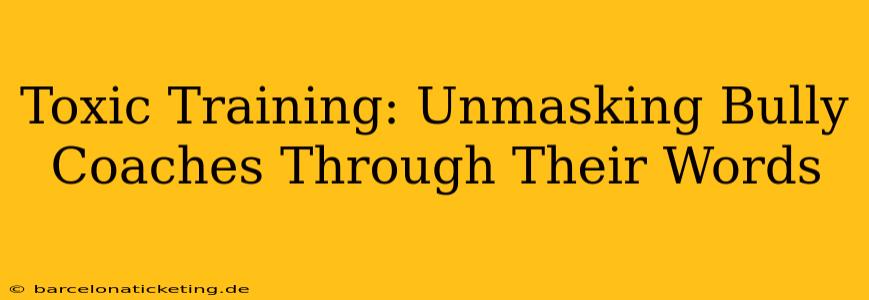Toxic coaching environments can severely damage athletes' mental and physical well-being. While overt physical abuse is easier to identify, the insidious nature of verbal abuse and manipulative tactics often goes unnoticed. This article will equip you with the knowledge to recognize the warning signs of a bully coach, focusing on the specific language they use to exert control and undermine their athletes. Identifying these red flags is crucial for athletes, parents, and administrators to create a healthier and more supportive sporting environment.
What are the signs of a bully coach?
Bully coaches often employ manipulative language and tactics to control their athletes. They might use intimidation, humiliation, and threats, subtly undermining confidence and self-esteem. This goes beyond simple tough love; it's about consistent patterns of harmful behavior masked as coaching.
How can you identify toxic coaching through language?
Identifying toxic coaching behavior often relies on recognizing specific verbal patterns. Here are some examples:
Constant Criticism and Belittling:
Bully coaches frequently engage in excessive and unwarranted criticism, often focusing on personal flaws rather than performance improvements. Instead of constructive feedback, they might use phrases like:
- "You're useless."
- "You're a disgrace to the team."
- "You're so stupid, you can't even..."
- "I've seen toddlers with better skills than you."
- "You're letting the team down." (repeatedly, without specific examples)
These comments aim to break down the athlete's confidence and self-worth, creating a dependence on the coach's approval.
Public Humiliation and Shaming:
A bully coach will use public settings to criticize and humiliate athletes, aiming to exert dominance and control. This might involve:
- Yelling at athletes in front of teammates or spectators.
- Making fun of athletes' mistakes in a humiliating manner.
- Singling out athletes for public ridicule during practices or games.
- Using sarcasm and condescending remarks in front of others.
Threats and Intimidation:
Bully coaches often use threats to control athletes' behavior. This can range from subtle implications to overt threats:
- "If you don't improve, you're off the team." (without offering support for improvement)
- "I'll make sure you never play again."
- Implied threats about playing time or scholarship opportunities.
- Using intimidating body language or tone of voice.
Controlling and Manipulative Language:
Bully coaches use language to control athletes' thoughts and feelings. This often involves:
- Gaslighting: Making athletes doubt their own perceptions and memories.
- Guilt-tripping: Making athletes feel responsible for the coach's emotions or actions.
- Using manipulative praise: Offering praise with a hidden threat or criticism. (e.g., "That was good, but you could have done better.")
- Ignoring or dismissing athlete concerns.
Are all tough coaches bullies?
It's crucial to differentiate between a demanding coach who pushes athletes to their limits and a bully coach who uses verbal abuse and manipulation. A demanding coach provides constructive criticism, focuses on improvement, and fosters a supportive environment. A bully coach uses intimidation and humiliation to control athletes. The key difference lies in the intent and the impact on the athletes' well-being.
How to address toxic coaching?
If you witness or experience toxic coaching, it’s essential to take action. Document instances of verbal abuse, gather support from teammates or parents, and report the behavior to appropriate authorities, such as school administrators, league officials, or governing bodies. Remember, a healthy sporting environment prioritizes athletes' well-being and development. Silence enables the behavior to continue, while reporting provides the possibility for change.
What are some resources for athletes dealing with bully coaches?
Several organizations provide support and resources for athletes facing bullying or harassment in sports. Seeking help from these resources can provide guidance, support, and a path towards creating a healthier sporting experience. (Note: Specific links to organizations are omitted per the instructions, but a simple web search can easily provide relevant resources for your region.)
This article aims to provide a comprehensive guide to identifying toxic coaching through language. By recognizing these patterns, we can work towards creating safer and more supportive environments for all athletes. Remember, athletes deserve to thrive in sports, not to endure verbal abuse and manipulation.

